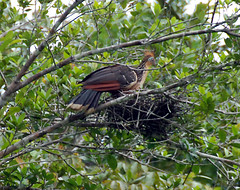 Image via Wikipedia Image via Wikipedia |
The Greater Adjutant, the rarest of 19 species of storks on earth, is found in India and Cambodia. The name is derived from their stiff "military" gait when walking on the ground. There are only 800 of these five feet tall, large billed, bare headed birds left in the world. Their main diet is carrion and they can often be found on garbage dumps. The video below is from PBS’s Nature: The Beauty of Ugly and shows a little of their story. Watch the video: http://youtu.be/OBskuBPNcYo
Some other notable nesters:
- Red-breasted Nuthatches dab globs of pine tree pitch/sap below the hole to restrict predator access.
- Great Crested Flycatchers decorate the entrance of its nest with a shed snakeskin or a clear plastic wrapper to scare away predators.
- Sociable Weaver or Social Weaver combines forces and takes over entire trees to build a large compound of community nests. Up to 300 pairs of birds come together to build giant mega-nests up to 25 feet wide, 5 feet high and with an individual room for every couple. As with a huge condo complex, there are multiple ‘basement’ entrances that lead up through clusters of chambers.
- Black Kites use white plastic litter to line their nests, apparently to signal strength and aggression or to camouflage their white eggs.
- Megapodes, also known as incubator birds or mound-builders, build a large compost heap of decaying vegetation and then bury their eggs inside to incubate.
-
Hoatzins, found in the rainforests of South America, nest in small colonies. They lay 2–3 eggs in a stick nest in tree branches hanging over water in seasonally flooded forests. Then if they’re threatened by a predator, the Hoatzin chicks leap into the water. When the danger passes they climb back into the nest. Hoatzin chicks have two claws on each wing to help them climb in the tree. These claws disappear as the bird grows older. Image by dermoidhome via Flickr
Image by dermoidhome via Flickr - Bowerbirds are master builders. But they don’t actually build a nest, just a bachelor pad to woo females. When a female arrives to inspect the bower, the male struts and sings. If mating takes place, the female then flies off to build a nest close by, leaving the male to try to convince another female to join in a romantic tryst. The video below shows one elaborate structure. Watch the video: http://youtu.be/GPbWJPsBPdA


No comments:
Post a Comment